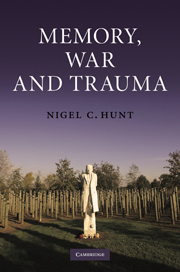Book contents
- Frontmatter
- Contents
- Preface
- 1 Background and purpose
- 2 Historical perspective
- 3 Methods and ethics
- 4 Current theory: post-traumatic stress disorder
- 5 Approaches to understanding trauma
- 6 Positive outcomes of traumatic experiences
- 7 Memory and history
- 8 Personal narrative and social discourse
- 9 Illustrating narrative as a scientific technique: the role of social support
- 10 Ageing, trauma and memory
- 11 Literature and trauma
- 12 Memorialisation and commemoration
- 13 Battlefield tours
- 14 Conclusions and future directions
- References
- Index
5 - Approaches to understanding trauma
Published online by Cambridge University Press: 05 June 2012
- Frontmatter
- Contents
- Preface
- 1 Background and purpose
- 2 Historical perspective
- 3 Methods and ethics
- 4 Current theory: post-traumatic stress disorder
- 5 Approaches to understanding trauma
- 6 Positive outcomes of traumatic experiences
- 7 Memory and history
- 8 Personal narrative and social discourse
- 9 Illustrating narrative as a scientific technique: the role of social support
- 10 Ageing, trauma and memory
- 11 Literature and trauma
- 12 Memorialisation and commemoration
- 13 Battlefield tours
- 14 Conclusions and future directions
- References
- Index
Summary
Theories of traumatic memory are in large part consistent regarding the structure and processes involved in traumatic memory; though they tell different parts of the story, they converge fairly well, even if there is disagreement over the terms used. Traumatic memory is an area where we can integrate work across different approaches in psychology, including biological, cognitive, social and psychodynamic perspectives. This chapter provides an outline of the different approaches, and how they cohere.
Cognition and emotion
A great deal of research has been carried out to determine the impact of trauma on basic cognitive processes such as attention and perception. The findings indicate that people who are traumatised are more likely to pay more attention to, and be more perceptually aware of, environmental stimuli that remind them of the traumatic event than people who are not traumatised. This is understandable from an evolutionary point of view. If a person has experienced a traumatic event and survived, then they will be programmed to respond quickly to similar environmental stimuli and hence increase their chances of surviving again. The traumatised person is distinguished from the non-traumatised one in being unable to separate the traumatic situation from the normal environment.
Attentional bias has been demonstrated through the Stroop test. The original Stroop test consisted of the rapid presentation of colour words that were presented either in the same coloured ink or in different coloured ink. The participant has to say what colour the ink is, and their reaction time is measured.
- Type
- Chapter
- Information
- Memory, War and Trauma , pp. 61 - 80Publisher: Cambridge University PressPrint publication year: 2010
- 2
- Cited by



